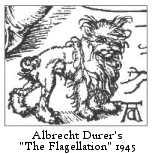|
Tale of two stories.
The Löwchen is a very old breed. Where it
comes from cannot be determined conclusively, but there is much evidence to
suggest its history. Currently there are two schools of thought over the
breeds history. While the two schools agree that the breed descends from an
ancestor tracing to Tibetan type dogs, this is where the agreement ends until
the later history resumes during the latter part of the medieval period. The
original belief was that the Löwchen was developed in the Mediterranean and
made its way from there into the northern regions of Europe, to Germany,
France and Holland. If this belief is adhered to, then one would also believe
that the Löwchen is also a member of the Bichon family. This was the story of
the breed until the late 1980's when extensive research was conducted for a
Löwchen book. The research came up with another alternative story, which is
supported by a large amount of evidence. Whichever history one chooses to
believe in, we all have to agree that it is unlikely that we will know in our
life times the true history of the breed. Someday, a canine genome project
will probably be able to sort out which breeds trace to what ancestors,
hopefully revealing the true ancestors of our beloved breed.
The
Löwchen in Art and Folklore.
 The
earliest evidence of the Lowchen traces to the 1400's in Germany and Holland.
We know that the breed has strong roots in Germany and Holland since most of
the breed's early evidence stems from these countries. Besides written
references, the breed can be found in many artworks dating from the medieval
times. Among the best known are the Albrecht Durer Löwchen which abound in
several of his important works. The Löwchen he drew in 1500, could be the
Löwchen reclining in today's living room. The
earliest evidence of the Lowchen traces to the 1400's in Germany and Holland.
We know that the breed has strong roots in Germany and Holland since most of
the breed's early evidence stems from these countries. Besides written
references, the breed can be found in many artworks dating from the medieval
times. Among the best known are the Albrecht Durer Löwchen which abound in
several of his important works. The Löwchen he drew in 1500, could be the
Löwchen reclining in today's living room.
There are so many illustrations
of Löwchen in both well-known masterpieces and obscure works that one could
spend a lifetime making incredible discoveries.
The Löwchen enjoyed
popularity for many centuries as a companion dog to the ruling classes and
average person alike. There are many charming stories of the breed's
purposes.
In one, a stone statue of a Löwchen is placed at the foot of a
tomb housing a knight's body, if he died of peaceful causes. If he died a war
casualty then a mighty lion was positioned signifying the knights' valor.
Another tale attempts to explain the haircut by telling of the ladies of the
court who take the dog to bed with them since they believed its shaved body
served as a hot water bottle.
In 1555 Conrad Gessner wrote of the breed in
"Histories Animalium" making this the first written reference to
the breed. The Löwchen was included in written classifications of dogs from
that time on, under varying names but usually as the "Lion Dog".
The other names, depending on the time period were Shoshundle, Gutchen Hund,
and Petit Chien de Lion. Löwchen is a German word with a diminutive attached.
It means little lion.
The breed was referenced in many dog books or in old
encyclopedias. Among the books one can find the Löwchen in, are; Hutchinson's
Dog Encyclopedia, Cassell's New Book of the Dog, Das
Edlen Hundes, The Animal Kingdom by Professor Gmelin,
and The Dog which was published in 1781. |
|